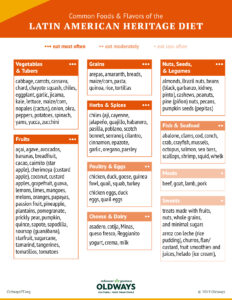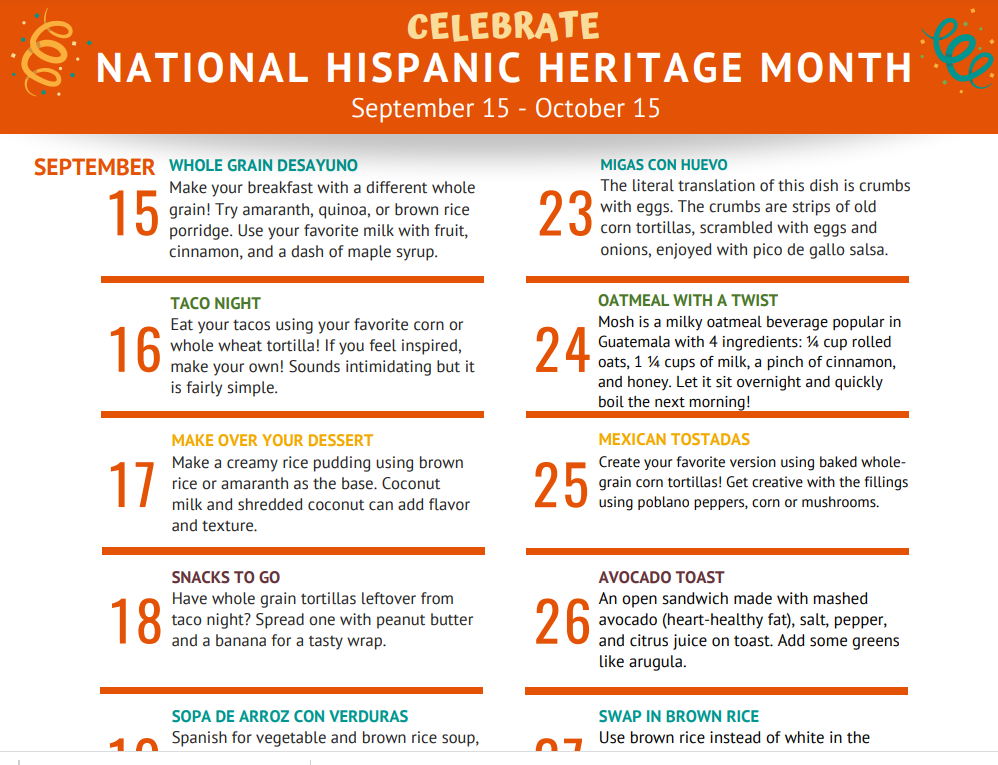Sylvia Klinger DBA, MS, RDN, is an award-winning author, entrepreneur, and founder of Hispanic Food Communications. She loves all about nutrition, developing delicious authentic healthy recipes, traveling the world, and spending time with her family. As a food and nutrition Communications professional, Dr. Klinger is a global nutrition professor and the founder of Hispanic Food Communications.

I was born in Puerto Rico to an adventurous missionary family with European, Sub-Saharan African and Indigenous American ancestry composition. That explains why I have lived and traveled overseas all of my life. Since my humble upbringing in Puerto Rico and Mexico, I have continued a legacy of compassionate service and cultural diversity.
To me Latin American Heritage Foods means preserving the foods and traditions we grew up with no matter where we end up living. No matter how long we have lived in the US, eating our traditional foods brings us a special comfort that nourishes the body and soul.
Latin American Heritage cuisine has an abundance of delicious dishes from diverse cultures and traditions. Could you share with us some ingredients and dishes you grew up eating
I remember eating hot cereals from corn (maicena or atole) and oatmeal both made with milk and with sugar or fried eggs with an assortment of fruits and a piece of local cheese for breakfast on most days. And rice with beans almost every day for lunch and dinner, accompanied with a starchy vegetable such as yucca, plantains or sweet potatoes. Meals were a family aair, everyone helping to get the meal on the table. Because of my Puerto Rican and Mexican upbringing, I incorporate a mix of dishes from Puerto Rico and Mexico. Therefore, we grew up making with favorite dishes such as arroz con gandúles, sweet or savory plantains, chilaquiles, quesadillas, enchiladas, arroz con pollo, and many sh dishes cooked in a green or red sauce. For dessert, we had pan dulce, which we also ate for breakfast or a snack, different types of an, coconut desserts, and a variety of cakes and ice cream.
What inspired you to pursue a career in nutrition
Although, my mom, who is also a registered dietitian, inspired me, my interest really took place in high school during a casual conversation with one of my childhood friends. She was so excited about everything she was learning in her nutrition class and that conversation sparkled my interest. What she was sharing was fascinating and really got me thinking. That very afternoon I ran home and told my parents I wanted to become a dietitian. I have been living my dream career ever since that day. Nutrition became my passion.A
Can you share a cooking or nutrition tip with our readers that you incorporate in your day-to-day life
I have accumulated hundreds of great nutrition and cooking tips, but let me share my top favorites:
Favorite cooking tip: first, get organized in the kitchen pick your favorite recipes with the family and start building a weekly menu by starting with the main dish with a protein, then adding a side vegetable and/or fruit, a grain and a low-fat dairy product. Every meal should have a representation of at least three food groups. Luckily many of our dishes already have at least three food groups represented in the dish. Think enchiladas, arroz con pollo/vegetables or tacos de pescado. Secondly, do an inventory of your pantry and refrigerator before going grocery shopping. This will save you time and money. These simple steps will make your family meals easier, nutritious and more enjoyable.
Favorite nutrition tip: Latinos are obsessed with bold flavors, to say the least, so adding flavor is key. For example, in savory dishes use more fresh herbs, onions, garlic, chile, and citrus juices. Also, spices such as cumin, epazote, low sodium adobo and sauces like sofrito or green/red salsas are great substitutes for salt and saturated fats. When trying to make desserts a little healthier, use low-fat dairy, and more spices such as vanilla, cinnamon, ginger, and citrus juices, instead of adding sugar.
How do you encourage your Hispanic clients and patients to celebrate their heritage not just during Hispanic Heritage month but all year round
Latinos are usually celebrating something or having a esta with family and friends almost every weekend. However, I remind them of the importance of continuing to incorporate our traditional foods we grew up with, especially the foods we love that are nutrient-dense, which bring so many health benefits. Fruits (citrus and tropical fruits), vegetables (zucchini, tomatoes, sweet potatoes), beans/legumes, seafood, grains and dairy foods are some of the favorite foods loaded with nutrients, which provides a lot of benefits that can lower the risk for chronic diseases.
What do healthy tips do you have for enjoying Latin American Heritage foods on a budget
First, check your refrigerator and pantry to make sure you are purchasing the items you dont have at home. Secondly, dont go to the supermarket hungry, which can make you grab more items than anticipated. Third, get creative with leftovers. A leftover picadillo from can be used for tacos the next day. Fourth, be mindful of portion sizes. Serving age-appropriate portion sizes can help your family and friends from overeating. I usually recommend serving food on smaller plates and cups and eating slowly to savor every bite. Fifth, bring discount coupons or take advantage of any weekly discounted items.
Whats next for you and your organization, Hispanic Nutrition
Global health has taken a priority on my agenda. As more people migrate to the US, we need to become more aware (and embrace) our differences, which makes us so unique. For the last few years I have been focusing on global health by teaching nutrition in other countries and getting involved with organizations that are involved in nutrition research and community projects around the world. These global projects have helped me better understand not only my Latino communities, but also the many cultures and traditions of those we serve every day.
More resources to help you celebrate Hispanic Heritage Month:
Take (or Teach!) Latin Heritage Diet Cooking Classes
Ready to get started in the kitchen Learn more about the Latin Heritage Diet in our A Taste of Latin Heritage (ATOLAH) cooking classes! Find a class near you in our class directory, or sign up for more information about becoming a teacher. Anyone can get certified to spread the word about this healthy and delicious lifestyle! Learn more
Foods & Flavors of the Latin American Heritage Diet
Did you know that some of the worlds favorite foods, like tomatoes and potatoes, originated in Central and South America The chart below shows some common and uncommon foods and flavors of the Latin American Heritage Diet Pyramid.
Download a list of traditional Latin American Heritage Diet foods.
The Latin American Diet and Health
Latin Americans those who trace their ancestry to Cuba, Mexico, Puerto Rico or Central America and South America are the fastest-growing group in the United States. Traditionally, a diet filled with whole grain corn, vegetables, fruits, beans, rice, herbs and spices has combined with a strong emphasis on family life, to support good health.
As Latin Americans adopt a more typically Americanized diet and lifestyle, however, they are at higher risk for many chronic diseases. According to the U.S. Centers for Disease Control and Prevention, these heightened risks vary among Latin Americans, and include:
- A higher prevalence of overweight and obesity among Mexican American men, compared to non-Hispanic white men and non-Hispanic black men.
- Higher rates of asthma among Puerto Ricans 2.2 times that of non-Hispanic whites, and 1.8 times that of non-Hispanic blacks, while Mexican Americans have some of the lowest rates of lifetime asthma.
- A diabetes death rate for Latin Americans that is almost one-and-a-half times higher than for non-Hispanic whites.
Although all these health problems cannot be addressed solely through diet, a return to some of the traditional foods that sustained their ancestors, as detailed on Oldways Latin American Diet Pyramid, can often help Latin Americans maintain or regain their health. In fact, a growing body of research shows that Hispanics who keep their traditional diet habits enjoy better health than those who adopt the Standard American Diet. Please visit our Health Studies page, to search for studies that touch on Latin American health issues.
Check out our Latin Heritage Recipes
Find tasty recipes here.
Use our Hispanic Heritage Month Calendar as Inspiration
Try a different activity every day! Feel free to share on social media and tag us.











